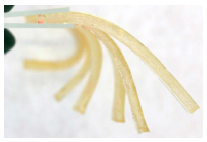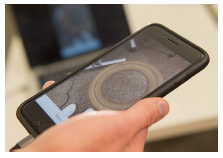Caffeine-Containing Biocompatible Gels for Drug Delivery
Trend Watch: Gels and AR advances create new methods of disease treatment, monitoring and diagnosis
Researchers at MIT may use caffeine to jump start their day, but they are also working on using it as a catalyst for a biocompatible polymer gel to enable drug delivery. Caffeine is more gentle and  easier on sensitive biological drugs than traditional metal catalysts. The biggest challenge with polymer material as a drug delivery tool is finding something to modify it to safely deliver a drug without destroying it.
easier on sensitive biological drugs than traditional metal catalysts. The biggest challenge with polymer material as a drug delivery tool is finding something to modify it to safely deliver a drug without destroying it.
Since many polymer gels require metal catalysts, which could pose risks to patients if traces remain in the gel, MIT researchers were inspired to find new catalysts that are based on food products and safe to ingest. Ergo: caffeine.
The resulting rubbery gel has significant potential as a drug delivery material. By changing the composition of the gel, the research team could vary its mechanical and chemical properties, allowing them to tune the strength of the material, and how quickly it released loaded drugs.
The researchers showed that they could load two malaria drugs, artesunate and piperaquine, into these polymers. They could also vary the chemical and mechanical properties of the gel by altering its composition. They created gels that contain either PEG or another polymer called polypropylene glycol, as well as some that combine those two polymers in different ratios.
This allows them to control properties such as the material’s strength, its surface structure, and the rate at which the drugs are released.
Augmented Reality App to Help Parkinson’s Patients Improve Their Gait
Bioengineering students at Rice University have developed a smartphone app that may help people with Parkinson’s disease improve their walking gait. These patients are combating a common  phenomenon known as freezing, a condition in which the legs take random pauses contrary to how the brain wishes them to move. Visual, audio, or vibratory cues can help overcome that, research has shown, and the Rice developers say their new app offers a comprehensive way to deliver all three of those cues.
phenomenon known as freezing, a condition in which the legs take random pauses contrary to how the brain wishes them to move. Visual, audio, or vibratory cues can help overcome that, research has shown, and the Rice developers say their new app offers a comprehensive way to deliver all three of those cues.
The app uses augmented reality (AR) to create objects near the floor that are visible through the phone. A user points the phone at the ground and the app can cast the image of a block or circle where the person’s foot should land in order to keep walking. The user steps through these virtual objects that appear regularly in front of the feet, which will hopefully help to develop a more natural walking style. There are also audio tones that can be activated that are designed to get a rhythm going.
The Rice student team worked with the Houston Area Parkinson Society to recruit patients to test the app at Rice’s Oshman Engineering Design Kitchen. The goal is to prove that the concept of augmented reality can be used in a therapeutic context while maintaining the user-friendly nature of smartphones.
The solution is smaller and cheaper than other mechanisms designed for the same purpose.
Disease-Responsive Hydrogel Aids Arthritis
Researchers at the Harvard-affiliated Brigham and Women’s Hospital have developed a disease-responsive hydrogel for anti-inflammatory drug delivery. The hydrogel could be injected into joints in patients with inflammatory arthritis for long-term local treatment. The gel breaks down in response to enzymes that are increased in an inflamed joint during an arthritis flare, meaning that it could provide anti-inflammatory treatment directly in response to disease severity, at the place it is most needed.
The hydrogel is designed so that drug release is triggered by the activity of specific, arthritis-related enzymes that are increased during flares. The concept relies on the action of inflammatory enzymes present in arthritic joints during flares to degrade the hydrogel in a controlled manner, allowing the drug to be released in response to the severity of the flare. When the research team incubated the gel with synovial fluid from a healthy human joint, it released very little drug. However, in synovial fluid from an arthritic joint there was significant drug release, which could be repeated several times by re-exposing the gel to more inflammatory synovial fluid to mimic arthritic flares.
In a mouse model of inflammatory arthritis, the hydrogel released more drug in response to increased disease severity and helped to reduce swelling, showing that the therapy has clinical potential.
Google Develops Augmented Reality Microscope for Detecting Cancer
Researchers at Google have developed an augmented reality microscope (ARM) that takes real-time data from a neural network trained to detect cancerous cells and displays it in the field of view of the pathologist viewing the images.
The prototype, which is configured to identify breast and prostate cancer cells, does not require hospitals or labs to replace their existing microscopes, as existing compound light microscopes can be retrofitted with a digital camera for feeding images to the machine learning algorithm and a custom AR display for overlaying the digitized results onto the user’s analog view. The findings were presented in April at the Annual Meeting of the American Association for Cancer Research.(PV)


















